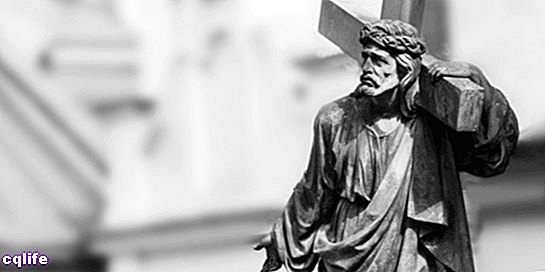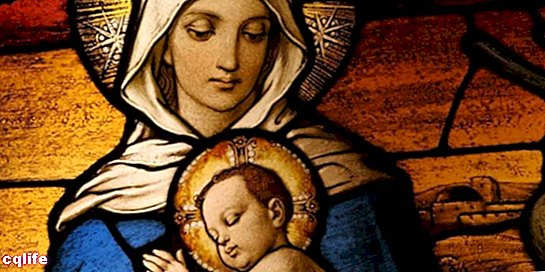- What is Christianity?
- Characteristics of Christianity
- Origin of Christianity
- Christian beliefs
- Branches of Christianity
- Christian rites
- Christianity and Judaism
We explain what Christianity is, its origin, beliefs and other characteristics. Also, its rites and relationship with Judaism.

What is Christianity?
Christianity (in some contexts called Christianity), is one of the largest religions monotheists of the planet. Its influence on Western culture was decisive and fundamental from the moment of its massification and popularization around the fourth century, when it became the official religion of the Roman empire.
The term "Christian" comes from the Greek Kristós, translation of the Hebrew word for "anointed", since in the tradition Hebrew kings were anointed with oil.
This word was used initially to call the prophet Jesus of Nazareth, the Christ, that is, the anointed one, the chosen one, and later gave rise to “Jesus Christ”. According to the Acts of the Apostles (11, 25-26) in the New Testament, his followers began to call themselves "Christians" in Antioch at the end of the 1st century.
Christianity is today the largest religion in the world, with approximately 2.4 billion faithful from different countries, cultures and ethnicities. It is the dominant religion in the West and has a strong presence in the rest of the world. continents. Its importance is such that we usually use the birth of Jesus Christ as a reference to fix the historical time: before Christ (BC) and after Christ (AD).
However, Christian churches are not governed by one doctrine homogeneous and unique, but can be classified into a wide diversity of sects or branches, such as Catholicism, Protestantism and Orthodoxy. The faithful of each one are called Christians and are governed by the teachings of Jesus of Nazareth, whom they consider to be the messiah announced by the ancients. texts Old Testament Jews.
In addition, Christianity is an Abrahamic religion, that is, it recognizes the mystical and spiritual tradition associated with the prophet Abraham, which makes him related as a religion to Judaism and the Islam, as well as minor traditions such as Baha'ism, Mandaeism, and Samaritanism. In fact, the sacred texts of Christianity, Judaism and Islam have numerous points of contact.
Characteristics of Christianity
In general, Christianity is characterized by the following:
- It is a monotheistic religion (believes in only one god), Abrahamic (it follows the tradition of the prophet Abraham, like Judaism and Islam) and with strong Jewish roots.
- Its religious symbol is the cross or the crucifix, because the Romans killed Jesus Christ by crucifixion.
- Its sacred text the Bible, which encompasses the Old Testament (which corresponds to the ancient texts of the Jewish Torah) and the New Testament (which recounts the life and teachings of Jesus Christ).
- Its main prophet is Jesus of Nazareth or Jesus Christ, considered the Messiah of God on earth, sent to renew the sacred covenant between the humanity and its creator, and spread the necessary teachings to access eternal salvation.
- Christian worship is organized in churches that defend different interpretations of sacred texts and different ritual practices, but that coincide in the core of their doctrine: Catholicism, Protestantism and Orthodoxy.
- It is a religion of immense cultural and historical importance for the West and the entire world, since it provided essential ingredients of medieval and modern thought developed in Europe and then expanded to other geographies of the planet.
Origin of Christianity
Christianity was born in the Roman province of Judea, and began as a small Jewish sect, of apocalyptic beliefs and around 120 members, led by some of the apostles of Jesus of Nazareth. The events narrated in the biblical chapter Acts of the Apostles relate the formation of the cult, but they are not exactly rigorous historically.
The truth is that by the third century, the Christian cult already had thousands of followers and was the dominant congregation in the northern Mediterranean. By this time, an early Christian church had emerged, made up of Greeks and Jews. Its relevance was such that the Roman rulers, little given to religious persecution, did not take long to try to appease the cult, without being able to eradicate it completely.
However, in the 4th century Emperor Constantine I decreed freedom of worship, ending the persecution of Christians and allowing the Christian church an important participation in society. Although this was followed by a period of revival of the paganism (during the reign of Julian, "the Apostate"), the strength of Christianity was such that by the end of the 4th century it was already the official religion of the Roman empire.
Christian beliefs

The practices and beliefs Christianity may vary slightly from one branch of religion to another, but its core of fundamental beliefs, broadly speaking, can be summarized as follows:
- The world was created by a single almighty and loving God, as described in the Jewish texts of the Old Testament. Since then there have been numerous prophets who spread the sacred word, and the last of them all was Jesus of Nazareth.
- Jesus Christ is God's messiah on Earth, that is, his envoy and emissary. Jesus is both his only son and his way of becoming flesh, that is, of becoming human and thus suffering the sufferings of humanity. He was born of a virgin woman, Mary, by the work and grace of the Holy Spirit, and died crucified at the age of 33, becoming a sacrifice to free humanity from its sins and renew its covenant with God.
- On the third day after his death, Jesus Christ was resurrected and ascended to heaven, where he rules at the right hand of the God-father. Meanwhile, the faithful await their second return, which will mark the end of time and the arrival of the final judgment, in which the dead will rise and be judged. The good and faithful will enter the kingdom of God, and the wicked and blasphemous will go to a place of eternal punishment, hell.
Branches of Christianity

As a religion, Christianity encompasses three major branches or sects, which are:
- Catholicism or the Catholic Church. The main and most numerous of the branches of religion, it includes 24 different churches (the Latin church and the Eastern churches) that are under spiritual and religious administration of the Pope, located in the Vatican City. His doctrine is the most traditional and contemplates not only Jesus Christ, but the long pantheon of Christian saints and martyrs. It has about 1,329 million faithful in the world.
- Orthodoxy or the Orthodox Church. Formally it is called the Orthodox Catholic Apostolic Church and it is considered the heir to Christianity of the eastern half of the Mediterranean, grouping 15 autonomous churches that recognize their sole authority in the spiritual, but that are considered related and form the same group. Orthodoxy was formally separated from Catholicism during the East-West Schism in 1054, and today it has around 300 million faithful worldwide.
- Protestantism or the Protestant Church. Protestantism was born in the 16th century with the so-called Protestant Reformation, whose initiator was Martin Luther (1483-1546), and who broke with many of the precepts of Catholicism, but especially with the idea of the infallibility of the Pope and with his unique authority over all Christians. Thus, different Protestant churches were born that adhere to Christianity, but that reinterpret it in a way more similar to the original Christian texts, thus moving away from Catholic doctrine. The Protestant churches are: the Anglican church, the Lutheran church, the Evangelical churches, the Pentecostal churches, the Baptist churches and the Restorationist churches. In all, Protestantism has an estimated 801,000,000 followers worldwide.
Christian rites

Christian rites can vary immensely, depending on the Christian church in which they are practiced. However, many of them coincide or are so essential that they are shared by all Christian branches, although not necessarily in the exact same way. For example:
- Baptism, an initiation rite to the Christian faith, typically carried out in childhood. It consists of submerging or pouring water on the head, imitating the initiation rite of John the Baptist to Christian followers in the Jordan River. The idea is that you enter the sinful water and emerge renewed, clean, ready for the covenant with God.
- Mass, a weekly meeting to carry out the Christian liturgy, on specific days and hours depending on the content to be read and the events to be commemorated, especially on important dates for the Christian religion, such as the birth of Christ (December 24) or the visit of the Magi (January 6).
- Communion, a rite of voluntary acceptance of the body of Christ, is celebrated in most Christian churches, either at the end of Mass, or as an important event in the entry of young Christians into the congregation, during the end of childhood. This last case is typical of Catholicism, which calls it the First Communion.
- Confession and penance, common in Catholicism and Orthodoxy, consist of the account of his own sins by the faithful to his priest, so that he may absolve him and guide him spiritually towards God's forgiveness. Broadly speaking, Christianity values the immortal soul above the perishable earthly body.
Christianity and Judaism
Christianity has its roots in ancient Judaism, so the two religions are closely related, although they do not profess the same beliefs. Fundamentally, the Jews adhere to their ancient tradition without valuing the Christian New Testament, regarding Jesus of Nazareth as, at best, just another prophet.
Since they do not believe that Jesus is the son of God, the Jews continue to await the arrival of the messiah and the final judgment, just as the scriptures announce. A similar case is that of Islam, also an Abrahamic religion, which has Jesus of Nazareth as another prophet in a long tradition culminating in Muhammad (Muhammed), prophet of Islam.
